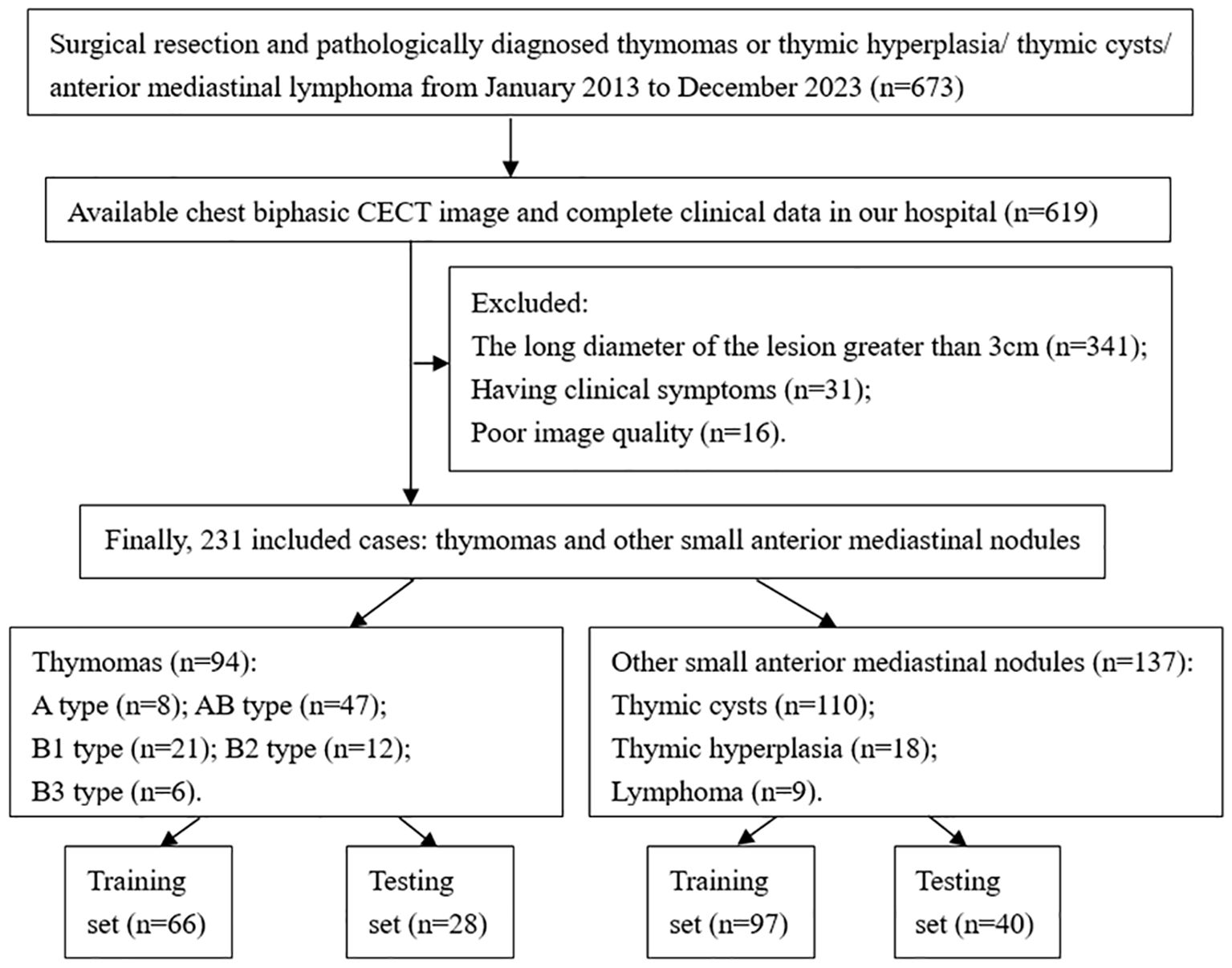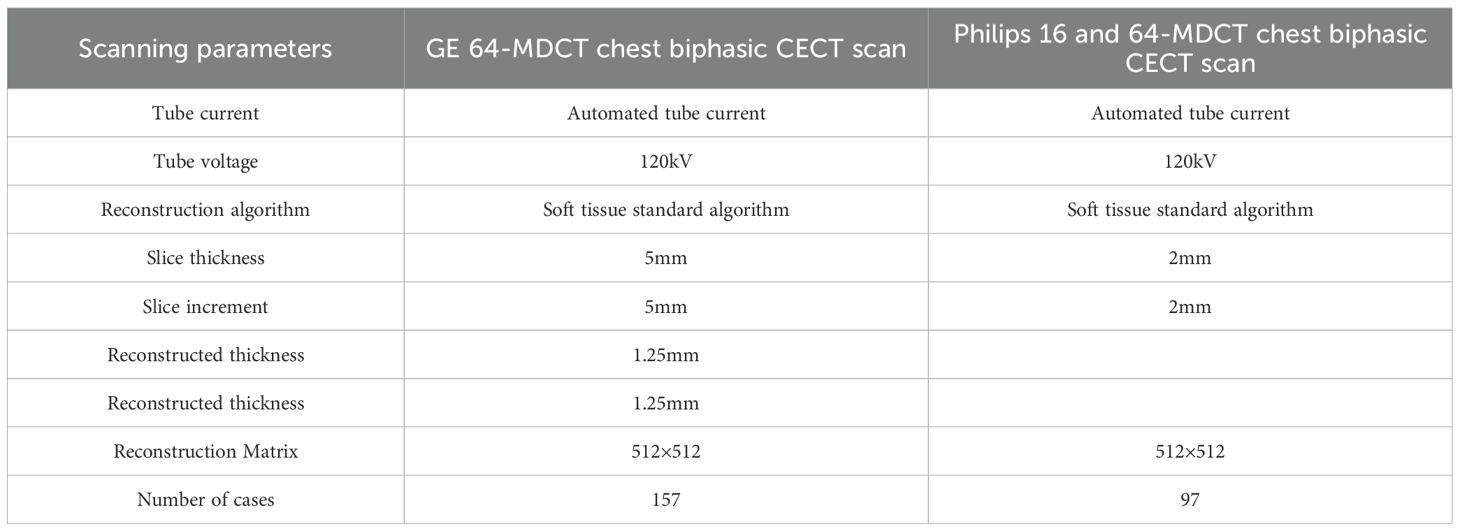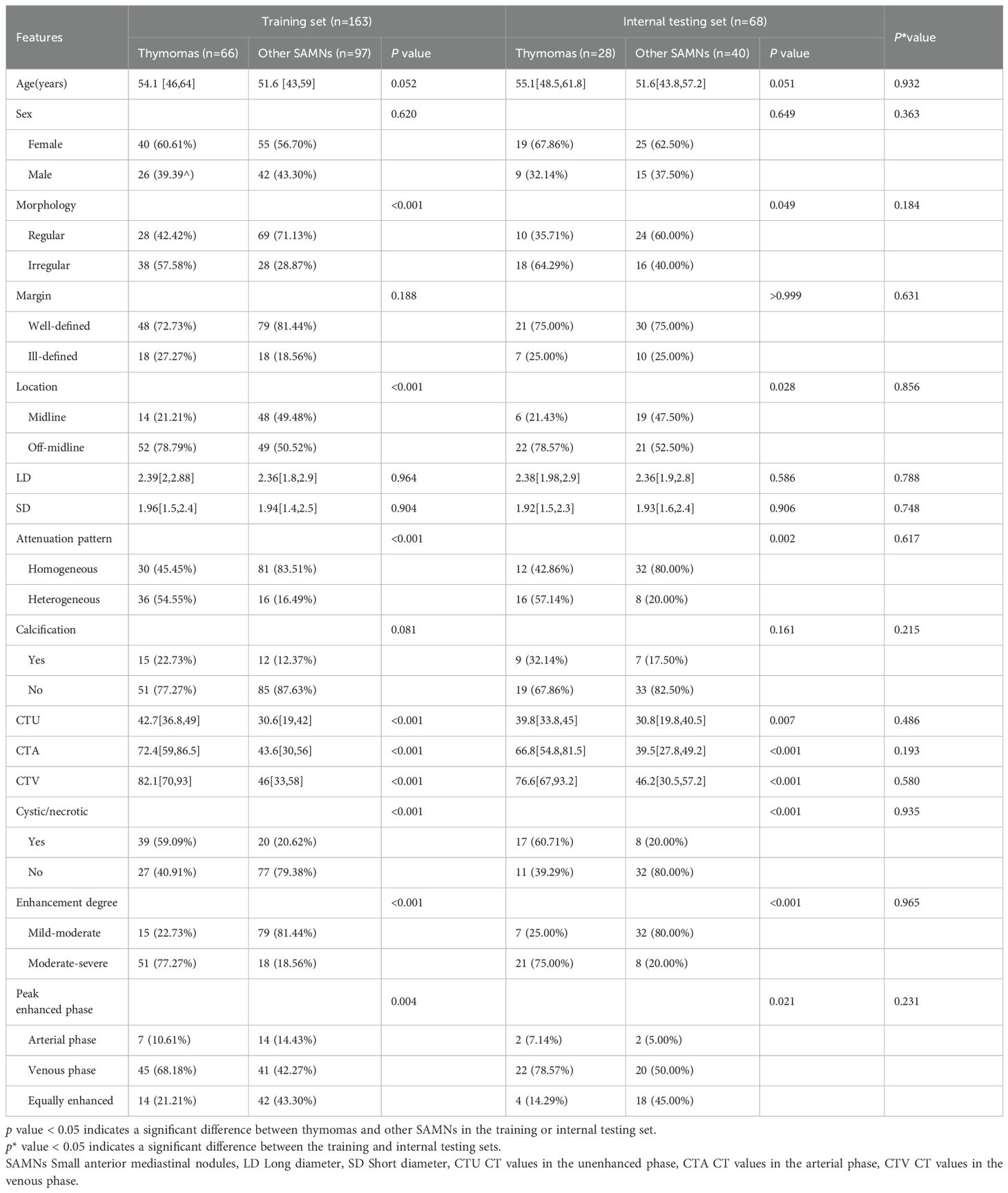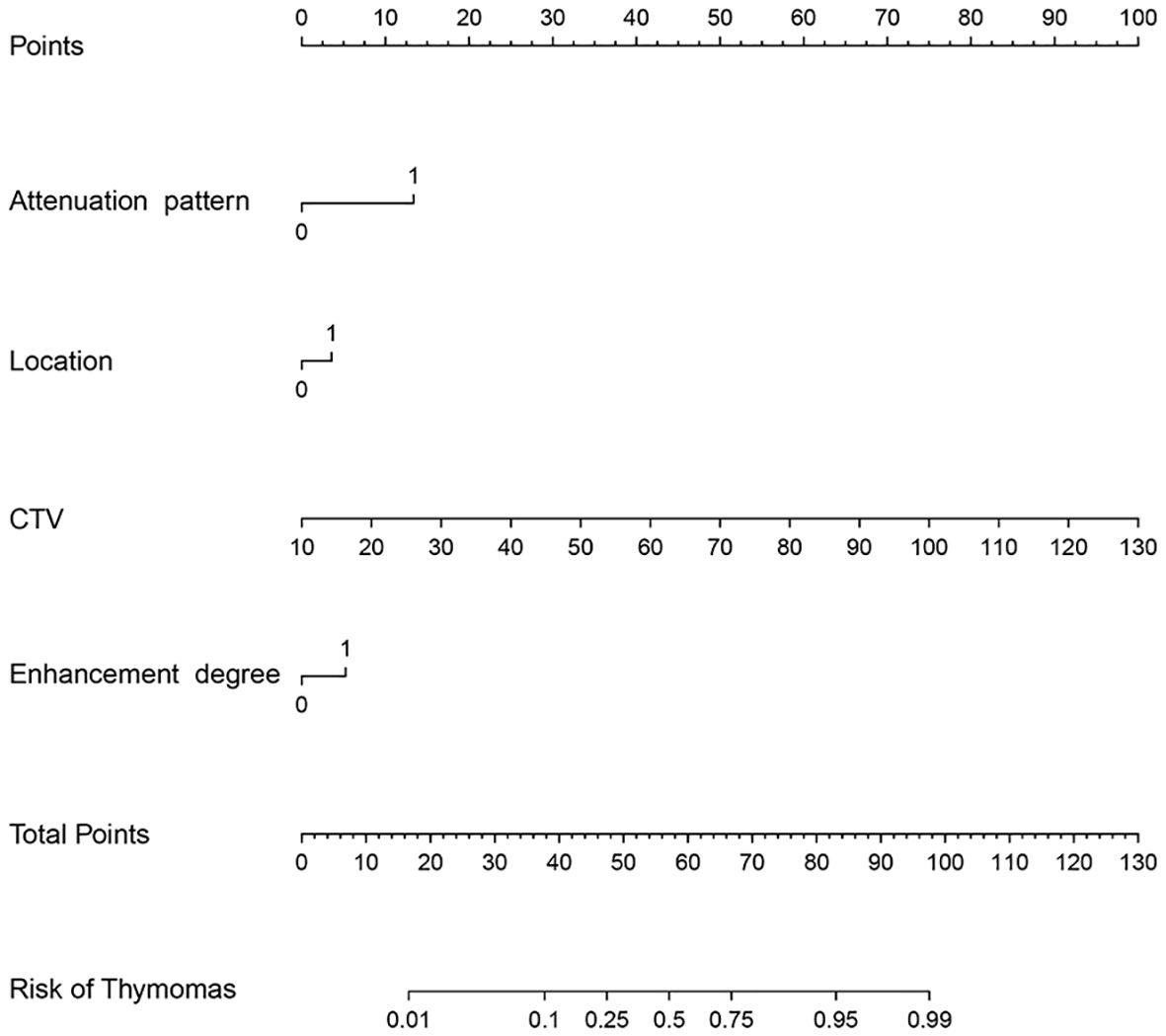- 1Department of Medical Imaging, The Second Hospital of Hebei Medical University, Shijiazhuang, Hebei, China
- 2Department of Nuclear Medicine, The Second Hospital of Dalian Medical University, Dalian, Liaoning, China
- 3Department of Central Laboratory, Hebei Key Laboratory of Molecular Oncology, Tangshan, Hebei, China
- 4Department of Breast Surgery, Tangshan People’s Hospital, Tangshan, Hebei, China
- 5Department of Neurosurgery, Tangshan People’s Hospital, Tangshan, Hebei, China
- 6Department of Nuclear Medicine Imaging, Tangshan People’s Hospital, Tangshan, Hebei, China
Purpose: To develop and validate a logistic regression (LR) model to improve the diagnostic performance of chest CT in distinguishing small (≤3 cm in long diameter on CT) thymomas from other asymptomatic small anterior mediastinal nodules (SAMNs).
Materials and methods: A total of 231 patients (94 thymomas and 137 other SAMNs) with surgically resected asymptomatic SAMNs underwenting plain CT and biphasic enhanced CT from January 2013 to December 2023 were included and randomly allocated into training and internal testing sets at a 7:3 ratio. Clinical and CT features were analyzed, and a predictive model was developed based on independent risk features for small thymomas using multivariate LR in the training set. Receiver operating characteristic (ROC) curves and decision curve analysis (DCA) were used to compare the performance of the model and individual risk factors in the internal testing set. An additional prospective testing set (10 thymomas and 13 other SAMNs) was collected from the same institution between 2023 and 2024. The model’s performance was evaluated by area under the curve (AUC) and compared with the results of three radiologists using the DeLong test.
Results: The LR model incorporating four CT independent risk features (lesion location, attenuation pattern, CT values in the venous phase [CTV], and enhancement degree) achieved an AUC of 0.887 for small thymomas prediction. This performance was superior to CTV alone (AUC = 0.849, P = 0.118) and significantly higher than other individual risk factors in the internal testing set (P < 0.05). DCA confirmed the model’s enhanced clinical utility across most threshold probabilities. In the prospective test set, the LR showed an AUC of 0.908 (95% CI: 0.765-1.00), comparable to the senior radiologist’s performance (AUC = 0.912 [95% CI: 0.765-1.00], P = 0.961), higher than the intermediate radiologist’s performance (AUC = 0.762 [95% CI: 0.554-0.969], P = 0.094), and significantly better than the junior radiologist’s performance (AUC = 0.700 [95% CI: 0.463-0.937], P = 0.044).
Conclusions: The CT-based LR model demonstrated well diagnostic performance comparable to that of senior radiologists in differentiating small thymomas from other asymptomatic SAMNs. CTV played a leading role in the model.
1 Introduction
With the increasing use of conventional chest CT, there has been a trend toward higher detection rates of asymptomatic anterior mediastinal lesions (1–4). As the most common anterior mediastinal tumor, all thymomas, including low-risk subtypes (A, AB, and B1), and high-risk subtypes (B2 and B3), are currently considered malignant neoplasms (5). Therefore, active surgical intervention remains warranted for thymomas due to their unpredictable clinical behavior, even in asymptomatic patients. While non-therapeutic thymectomy rates reached 22-44% in previous studies (6, 7), this may primarily stem from imaging mischaracterization of other anterior mediastinal pathologies (e.g., thymic cysts, thymic hyperplasia, and lymphoma) as thymomas. Consequently, accurate preoperative differentiation of thymomas using traditional imaging modalities is essential for guiding personalized therapeutic approaches.
CT has been conventionally used for the primary evaluation of anterior mediastinal lesions. However, distinguishing small thymomas (long diameter [LD] ≤3cm) from other anterior mediastinal lesions remains challenging due to overlapping imaging features. Wang et al. demonstrated that certain biologically benign thymic cysts with a diameter ≤3cm can exhibit CT features similar to thymomas (8). The possibility of misdiagnosis mainly stems from two imaging related factors: Firstly, small thymic cysts located near the aorta and sternum may show pseudo enhancement on enhanced CT, leading to the erroneous appearance of solid enhancement features of thymomas; Secondly, based solely on attenuation values, protein rich thymic cysts presenting with solid density on CT may be difficult to distinguish from low enhanced (hypovascular) thymomas. Notably, most incidentally detected anterior mediastinal lesions fall within this small size category (1, 2, 4). Magnetic resonance imaging (MRI) provides higher soft-tissue contrast resolution compared to CT, but its longer acquisition time increases susceptibility to motion artifacts by patient non-cooperation, thereby affecting image quality. In addition, the inherent lower spatial resolution of MRI compared to CT reduces its diagnostic accuracy in characterizing small anterior mediastinal nodules (SAMNs) (9–11). Finally, MRI is more expensive than CT and imposes a greater burden on patients. Although positron emission tomography (PET)/CT is becoming increasingly important in the diagnosis of mediastinal tumors, its clinical application is still limited due to the high cost and limited availability in many centers (12). Furthermore, biopsy procedures carry inherent risks given the proximity of anterior mediastinal lesions to vital cardiovascular structures (13, 14). Given these limitations, there is an urgent need to develop a non-invasive, cost-effective, and reliable method for predicting thymomas in patients with asymptomatic SAMNs.
The current consensus established by the National Comprehensive Cancer Network guidelines (15) states contrast-enhanced CT (CECT) is the gold standard imaging modality for mediastinal tumor evaluation, as it achieves the best balance between reliability, cost-effectiveness, and diagnostic accuracy. However, to our knowledge, only a limited number of studies (16–18) have investigated the CECT’s diagnostic performance for SAMNs. In addition, these studies were limited by sample selection bias, small sample sizes, or lack of comparison with radiologists’ interpretations. Critically, there is a paucity of studies on using machine learning algorithms based on CT to develop a model that can distinguish small thymomas from other SAMNs (including thymic cysts, thymic hyperplasia, and lymphoma) in a large number of patient cohorts with histopathological confirmation.
Therefore, the purpose of this study was to develop a predictive model based on conventional CT features using multivariate LR to effectively identify small thymomas in asymptomatic SAMNs, thereby reducing unnecessary thymectomy and alleviating the related economic and psychological burden on patients.
2 Materials and methods
2.1 Patients
This retrospective study was approved by the Institutional Ethics Committee of Tangshan People’s Hospital (Approval No. RMYY-LLKS-2024076) and conducted in accordance with the Declaration of Helsinki (2013 revision). Written informed consent was waived for retrospective data collection but obtained from all prospectively enrolled participants. For the retrospective cohort (January 2013-December 2023), inclusion criteria were: (1) Histologically confirmed diagnosis of small thymoma (LD ≤3cm) or other SAMNs (LD ≤3cm), including thymic cysts, thymic hyperplasia, and lymphoma; (2) Preoperative plain CT and biphasic CECT performed within 14 days prior to surgery, with no history of prior therapy; (3) Asymptomatic clinical presentation; (4) Complete clinical and imaging records; (5) Diagnostic quality CT images (defined as images without significant motion artifacts and with appropriate contrast opacification). The final retrospective cohort included 231 patients (94 thymomas; 137 other SAMNs) who were randomly assigned to a training (n=163; 66 thymomas, 97 other SAMNs) and an internal validation (n=68; 28 thymomas, 40 other SAMNs) sets using a 7:3 allocation ratio (Figure 1). Demographic characteristics (age and sex) were recorded and compared between groups.
The prospective validation cohort (January-December 2024) enrolled patients who met the following criteria: a) Asymptomatic SAMNs were incidentally detected on plain CT and biphasic CECT; b) Underwent surgical resection without prior biopsy or treatment (including intervention or targeted therapy). Finally, 23 patients were prospectively enrolled (median age: 54 ± 15 years; 8 males). Pathological diagnoses included small thymomas (n=10: type A=1, AB=6, B1 = 1, B2 = 2) and other SAMNs (n=13: thymic cysts=11, thymic hyperplasia=2).
2.2 Image protocol
CT examinations were performed using three scanner models: GE Discovery CT750 HD (GE Healthcare, Milwaukee, WI, USA), Philips Ingenuity Core 16, and Ingenuity Core 64 (Philips Healthcare, Best, Netherlands). The imaging protocol consisted of plain CT scan and biphasic CECT scan, including arterial phase (23 ± 2 seconds) and venous phase (56 ± 4 seconds). A total of 100 mL of non-ionic contrast agent (Iopamidol, 370 mg I/mL) was injected intravenously at 3 mL/s using a dual chamber power injector, followed by 20 mL saline flush. Detailed scanning parameters, including tube voltage, current, and reconstruction settings, are summarized in Table 1.
2.3 Imaging analysis
Two board certified radiologists with 6 and 10 years of thoracic imaging experience independently evaluated the CT features without knowledge of pathological diagnosis and clinical information. The assessment included: (1) Morphology: classified as regular (round/oval) or irregular (all other shapes); (2) Margin: categorized as well-defined or ill-defined; (3) Location: midline (lesion center directly posterior to sternum) or off-midline; (4) Size: LD and short diameter (SD); (5) Attenuation pattern: homogeneous or heterogeneous; (6) Presence of calcifications; (7) Enhancement characteristics: CT values in the unenhanced phase (CTU), arterial phase (CTA), and venous phase (CTV); Presence of cystic/necrotic components (non-enhancing low-attenuation areas). For quantitative analysis, circular regions of interest (ROIs) encompassing approximately 60-70% of the largest cross-sectional area were placed, carefully avoiding artifacts, calcifications, cystic/necrotic areas, and lesion peripheries. Three independent measurements were obtained and the average value was recorded as the final result. Enhancement degree was classified as follows: mild to moderate: enhancement increase <25 HU, moderate to severe: enhancement increase ≥25 HU, respectively (19). The peak enhancement phase was determined based on the maximum enhancement difference between arterial and venous phases: equal enhancement: interphase difference <5 HU; otherwise, the phase in which the maximum enhancement level was defined as the peak enhancement phase (20). Disagreements between the two radiologists were settled by consensus when evaluating CT features.
2.4 Observer study
Three radiologists independently evaluated the probability of thymomas in asymptomatic SAMNs within the prospective validation cohort. The evaluation panel comprised one senior radiologist (11 years of thoracic imaging experience), one intermediate radiologist (8 years of experience), and one junior radiologist (2 years of experience). Before evaluation, a thoracic imaging professor with more than 4000 cases of anterior mediastinal lesions review experience provided a training course for the three radiologists. This included a detailed analysis of 20 representative cases from our internal testing set, covering key imaging features and diagnostic criteria. To ensure unbiased assessment, all CT images were anonymous and presented in random order, and radiologists are unaware of all clinical and pathological information. Each clinician provided a probability estimate of thymoma ranging from 0% to 100%.
2.5 Statistical analysis and model development
All statistical analyses were performed using R software (version 4.4.2; R Foundation for Statistical Computing). Interobserver consistency was assessed using kappa for categorical features and intraclass correlation coefficients (ICCs) for continuous variables. The consistency level were interpreted as follows: Kappa values or ICCs of 0-0.20 as poor agreement, values of 0.21-0.40 as fair consistency, values of 0.41 and 0.60 as moderate consistency, values of 0.61 and 0.80 as good consistency, values greater than 0.81 as excellent consistency. Continuous variables were compared using Mann-Whitney U test, while categorical variables were analyzed using Fisher exact test or χ² test. Variables with p < 0.1 in univariable analyses underwent multivariable LR with backward elimination, and then the identified independent risk factors for thymomas were used to develop a LR model in the training cohort. Model validation was subsequently performed on both the internal validation set and prospective cohort. Model performance was assessed using receiver operating characteristic (ROC) curve analysis, and clinical utility was evaluated using decision curve analysis (DCA). The DeLong test was used to compare areas under the ROC curves (AUCs) between the model and clinician assessments. A two-tailed P value <0.05 was considered statistically significant.
3 Results
3.1 Interobserver consistency
The kappa values for categorical CT variables between the two radiologists were as follows: morphology 0.885, margin 0.848, location 1.000, attenuation pattern 0.874, calcification 0.944, cystic/necrotic 0.879, enhancement degree 0.902, peak enhanced phase 0.897. The ICCs for continuous CT variables between the two radiologists were as follows: LD 0.964, SD 0.936, CTU 0.948, CTA 0.970, CTV 0.968.
3.2 Comparison of clinical characteristics and CT imaging features in the retrospective sets
There were no significant differences in clinical or CT imaging variables between the training and internal testing sets, confirming the validity of random data grouping (Table 2; all p* > 0.05). There were statistically significant differences between small thymomas and other SAMNs in terms of lesion location, morphology, attenuation pattern, three-phase CT values, enhancement degree, cystic/necrotic, and peak enhancement phase (all p<0.05); However, no significant differences were observed in patient age, gender, lesion margin, SD, LD, and calcification (all p>0.05) (Table 2). Specifically, in the training and testing sets, 78.79% and 78.57% of thymomas were located off-midline, while only 50.52% and 52.50% of other SAMNs were located off-midline. The proportion of irregular shapes in thymomas was significantly higher in both the training (57.58% vs. 28.87%, p<0.001) and testing (64.29% vs. 40.00%, p=0.049) sets compared to other SAMNs. More than half of thymomas showed heterogeneous on plain CT scan, while most other SAMNs were homogeneous in both the training and testing sets. The CTU, CTA, and CTV values of thymomas were significantly higher than those of other SAMNs. In addition, 77.27% and 75.00% of thymomas showed moderate to severe enhancement in the training and testing sets, respectively, while other SAMNs were only 18.56% and 20.00%. The cystic/necrotic rate of thymomas was also significantly higher than that of other SAMNs. The peak enhancement of thymoma mainly occurred in the venous phase (68.18% of training and 78.57% of testing), while other SAMNs mainly occurred in the venous phase (42.27% of training and 50.00% of training) and equal enhancement (43.30% of training and 43.30% of training).
3.3 Predictive model
To avoid redundancy due to strong collinearity among CTA, CTU, and CTV (Supplementary Figure 1), only CTV was retained for subsequent analysis because of the highest AUC value. Nine variables with p < 0.1 at univariable analyses (including age, morphology, location, attenuation pattern, calcification, CTV value, cystic/necrotic, enhancement degree, and peak enhancement phase) underwent multivariable LR with backward elimination. Four independent risk factors of small thymomas (including location, attenuation pattern, CTV value, and enhancement degree) were used to develop the final LR model. In the training set, the AUC of the LR model was 0.926 [95% confidence interval (CI) 0.881-0.971], with specificity, sensitivity, and accuracy of 0.948, 0.803, and 0.890, respectively. In the testing set, its AUC was 0.887 (95% CI 0.807-0.967), with specificity, sensitivity, and accuracy of 0.850, 0.821, and 0.838, respectively (Figures 2A, B). Calibration curves demonstrated good agreement between predicted and observed probabilities in both cohorts (Figures 2C, D). Although the AUC of the LR model was higher than that of CTV, there was no significant difference (0.887 vs. 0.849, P=0.118); However, it was significantly higher than any other risk factor (P < 0.05; Table 3, Figure 3). DCA further indicated that compared to independent risk factors in the same cohort, the LR model exhibited stronger clinical utility across most threshold probabilities (Figure 4). The related nomogram showed that a lesion exceeding 58.15 could be considered a small thymoma, with an AUC of 0.926, specificity of 94.8%, sensitivity of 80.3%, and overall accuracy of 89.0% (Figure 5).
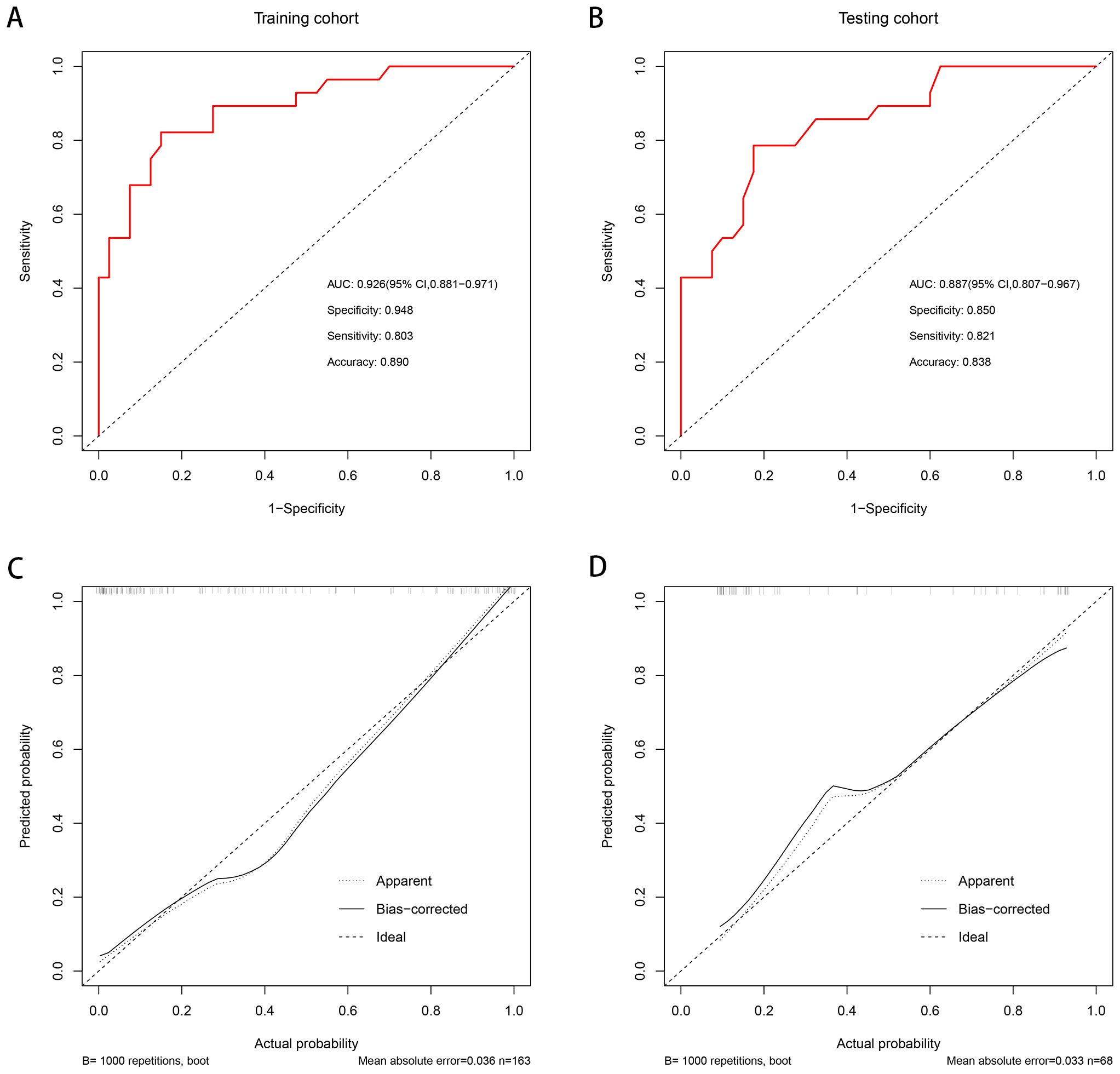
Figure 2. The AUC of the predictive model was 0.926 [95% CI 0.881-0.971], with a sensitivity, specificity and accuracy of 0.803, 0.948, and 0.890 in the training set, respectively (A). The AUC of the predictive model was 0.887 [95% CI 0.807-0.967], with a sensitivity, specificity, and accuracy of 0.821, 0.850, and 0.838 in the internal testing set, respectively (B). Good calibrations of the predictive model were shown in both the training (C) and internal testing sets (D).
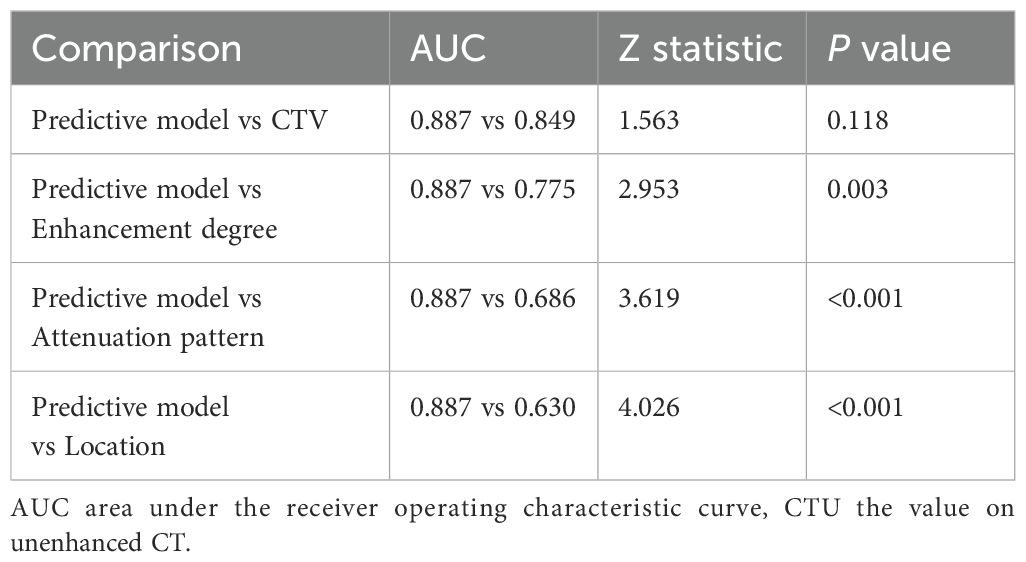
Table 3. The comparison of the AUCs between the predictive model and individual risk factors in the internal testing set.
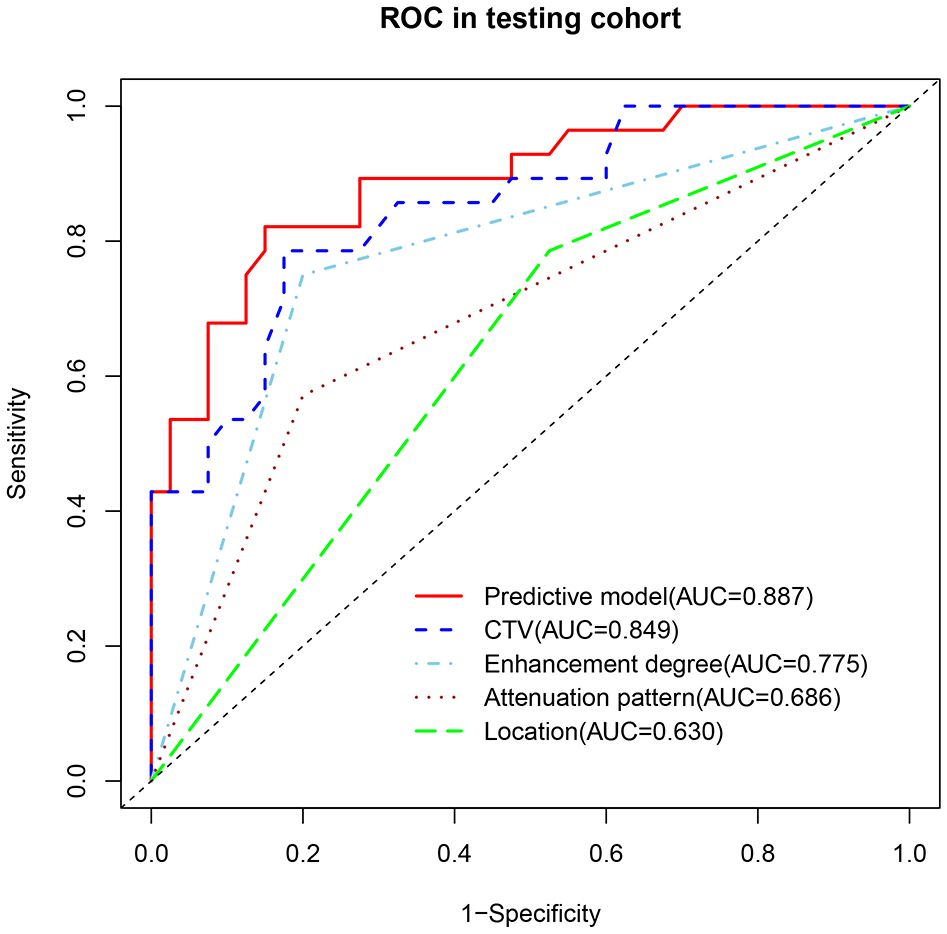
Figure 3. The AUC of the predictive model was higher than that of any individual risk factor in the internal testing set.

Figure 4. The predictive model exhibited enhanced clinical utility across most threshold probabilities when compared with independent risk factors in the internal testing set.
3.4 Comparison of the diagnostic performance between the nomogram and radiologists in the prospective testing set
In the prospective testing set, the nomogram achieved an AUC of 0.908 (95% CI: 0.765-1.00). At 90% specificity, the sensitivity was 90% (9 of 10 thymomas; 95% CI: 0, 100). The nomogram’s performance was comparable to that of the senior radiologist for both AUC (0.908 vs. 0.912, P = 0.961) and sensitivity at 90% specificity (90% vs. 90%, P > 0.999). Compared with the intermediate radiologist, the nomogram showed higher AUC (0.908 vs. 0.762, P = 0.094) and sensitivity at 90% specificity (90% vs. 50%, P = 0.141). In addition, compared with the junior radiologist, the nomogram demonstrated significantly higher AUC (0.908 vs. 0.700, P = 0.044) and sensitivity at 90% specificity (90% vs. 30%, P = 0.020) (Figure 6, Table 4). One representative case predicted by the nomogram and radiologists are shown in Figure 7.
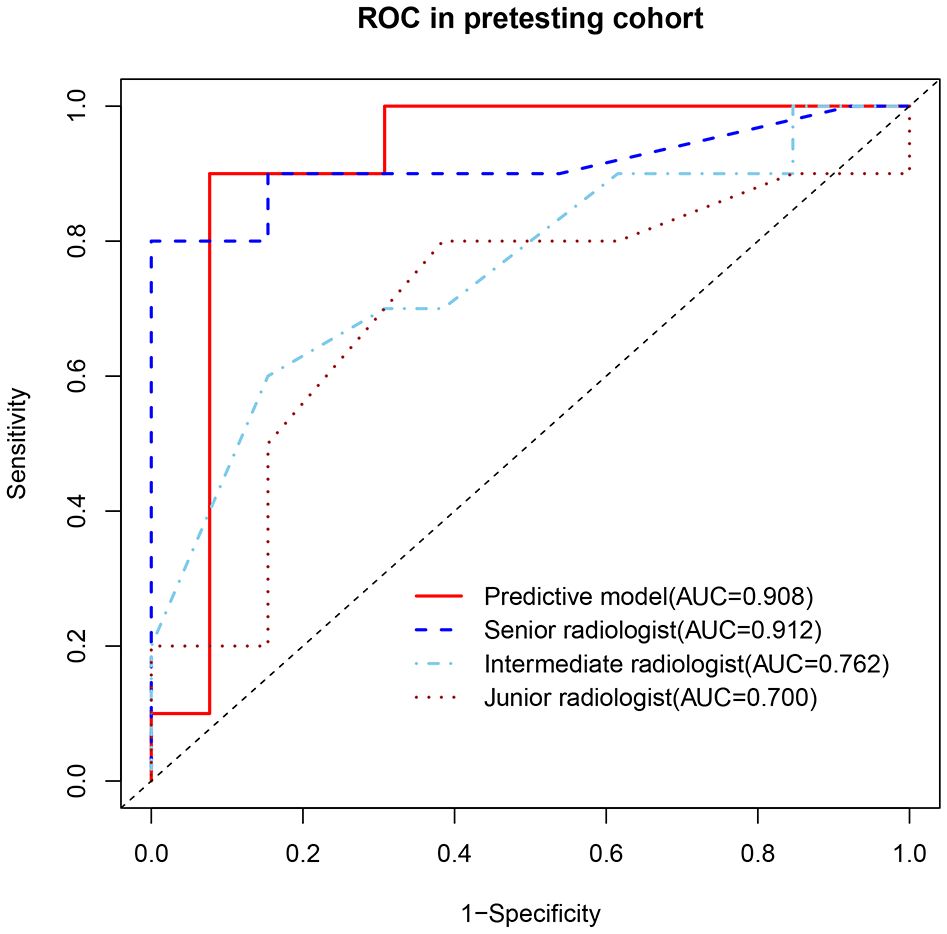
Figure 6. ROCs of the predictive model and radiologists in identification of thymomas from other small (≤3 cm) anterior mediastinal nodules in the prospective testing set.

Table 4. Performance of the predictive model and radiologists in identification of thymomas in the prospective testing set.
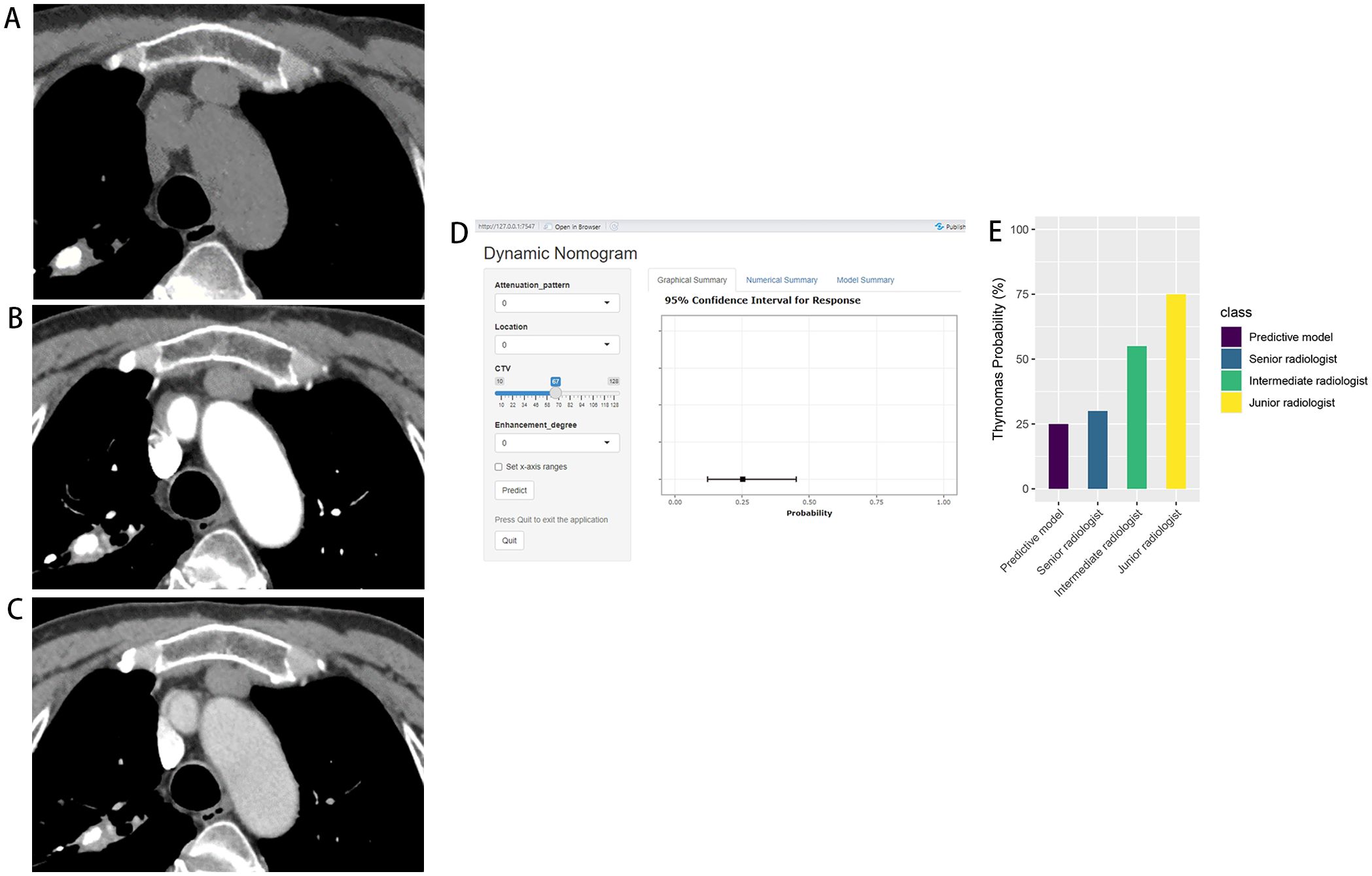
Figure 7. Thymic cyst in a 65-year-old woman. Axial CT scans in unenhanced (A), arterial (B), and venous (C) phases demonstrate a 2.0cm×1.8cm homogeneous anterior mediastinal nodule with middle location. The CTU, CTA, and CTV values of the lesion were 43HU, 55HU, and 67HU, respectively. Application of this case to the diagnostic nomogram (D) yielded a score of 47.5 points, corresponding to a 25% probability of thymoma. Graph (E) depicts that the predictive model exhibited higher confidence in diagnosing the lesion as non-thymoma compared with the senior radiologist (30%), whereas the intermediate radiologist (55%) and the junior radiologist (75%) were more inclined toward thymoma.
4 Discussion
In our study, we developed and validated an LR model based on traditional CT imaging features (including attenuation pattern, location, CTV, and enhancement degree) to identify small thymomas in patients with asymptomatic SAMNs. In the prospective testing set, LR model demonstrated robust performance in predicting small thymomas, with its ability comparable to that of the senior radiologist, higher than that of the intermediate radiologist, and significantly improved compared to the junior radiologist. These results suggest that the model’s high diagnostic accuracy could serve as a decision-support tool to reduce unnecessary examinations and non-therapeutic surgeries.
In recent years, few studies have systematically evaluated the diagnostic efficacy of conventional CT features for differentiating anterior mediastinal lesions ≤3 cm in diameter. Jin et al. (16) demonstrated that CECT showed promising diagnostic capability for distinguishing high-density thymic cysts from thymomas in sub-3 cm lesions, with AUC values of 0.95 for enhanced CT values and 0.96 for ΔCT values. But this study was limited by a small cohort (n=36). In addition, no nomogram was developed for providing a quantitative tool to predict an individual’s probability of thymomas. Although Jung et al. (17) developed a CT-based nomogram achieving 95% accuracy in differentiating thymomas from cysts in 100 patients with asymptomatic SAMNs, their study did not compare the nomogram with the diagnosis of radiologists and lacked sufficient statistical power due to moderate sample size. In addition, the two studies mentioned above also had a common limitation: they only distinguished between thymomas and thymic cysts, excluding thymic hyperplasia and lymphoma that need to be differentiated in normal diagnosis. To our knowledge, our study represents the largest sample size to date, incorporating 231 cases from retrospective analysis and 23 prospectively validated cases. Distinctively, our research framework included differential diagnosis between thymomas and various mediastinal pathologies, including thymic cysts, thymic hyperplasia, and lymphomas. And CT data obtained from different scanning machines and scanning parameters. In addition, we implemented a rigorous comparative analysis of the diagnostic performance between the LR model and radiologists with different experience levels. These methodological advances may potentially enhance the model’s generalizability and clinical robustness for distinguishing thymomas from other asymptomatic SAMNs.
CTV and enhancement degree were two independent predictive factors in our LR model for differentiating small thymomas from thymic cysts, hyperplasia, and lymphomas. Both demonstrated statistically significant discriminative ability. Thymomas exhibited significantly higher CTV values compared to other SAMNs, consistent with previous study (21). For instance, Xie et al. (21) observed that higher iodine concentrations in enhancing thymomas versus mediastinal lymphomas during the venous phase. Furthermore, thymomas were predominantly characterized by moderate to severe enhancement, while other SAMNs typically showed mild to moderate enhancement. This aligned with established findings (5, 16, 22, 23). Jung et al. (17) specifically identified enhancement degree as a key factor in distinguishing thymomas and cysts in small (<3 cm) thymic lesions. Priola et al. (24) also reported that enhancement degree was a risk factor in distinguishing thymoma from thymic hyperplasia, and pointed out that thymomas tended to have moderate to severe enhancement. These findings indicated that superior vascularity in small thymomas relative to other SAMNs, likely peaking during the venous phase. This hemodynamic pattern is associated with characteristic histopathology: thymomas are composed of neoplastic epithelial cells of thymus intermingled with non-neoplastic immature T lymphocytes, which are separated into lobules by fibrous bands and contain prominent perivascular spaces (25). These fibrous septa decreases the speed of withdrawal of contrast agents, resulting in a higher iodine concentration during the venous phase. In our analysis, the location of the lesion was also an independent risk factor for small thymomas. Up to 80% of thymomas showed an off-midline position, while only 50% of other SAMNs. This spatial distribution pattern was consistent with existing studies. Ackman et al. (6) reported that 82% of thymomas were off-midline, while 44% for thymic cysts, 26% of lymphoma, and 10% of thymic hyperplasia. Nam et al. (26) also reported that thymomas tended to preferentially occupy an off-midline position, while McErlean et al. (27) concluded that midline position was more common in benign thymic lesions. Attenuation pattern was another key independent predictor in our model. More than 50% of thymomas demonstrated heterogeneity on plain CT, while most other SAMNs showed uniformity, which was consistent with previous studies (7, 28, 29). Araki et al. (28) reported that an inhomogeneous attenuation on plain CT suggested thymoma rather than thymic cyst.
Although the independent risk features mentioned above had a certain discriminatory diagnostic ability when used alone, integrating these findings into a predictive model achieved excellent discriminative ability, comparable to the subjective evaluation of senior radiologists in a prospective cohort. It was worth noting that the diagnostic accuracy of intermediate and junior radiologists in the prospective cohort was limited when relying solely on diagnostic experience. This finding highlights the special diagnostic challenges posed by asymptomatic SAMNs for less experienced radiologists. Furthermore, the inherent variability of diagnostic experience limits the reproducibility when radiologists predict thymomas alone. In contrast, our nomogram-based approach provides an exact probability of thymoma, regardless of the radiologist’s experience. Therefore, even clinical physicians can objectively predict the accurate probability of small thymoma by inputting four easily obtainable CT features (CTV value, enhancement degree, location, and attenuation pattern) into the nomogram. This standardized quantitative evaluation may be more reliable in distinguishing small thymomas from other SAMNs than individual experiential radiological interpretation.
Critically, our LR model facilitates accurate identification of small thymomas among asymptomatic SAMNs, which may reduce unnecessary thymectomy rates. This could generate significant health economic benefits: despite the low mortality rate of non-therapeutic thymectomy, the documented complications and healthcare costs remain a concern. Kent et al. (7) reported that based on a ten-year national sample of hospitalized patients, the total cost of non-therapeutic thymectomy exceeded $16 million. Furthermore, even if surgical recovery is not complicated, indirect costs caused by productivity loss need to be considered.
Nevertheless, this study has several limitations. Firstly, the predictive model was developed using surgical patient data exclusively. Including non-surgical cases could provide a more realistic SAMNs’ distribution, which may enhance the generalizability of the model. Secondly, our study employed a single center design and lacked external validation. Future multicenter research could improve the performance of predictive models to some extent. Thirdly, the small sample size of the prospective test set may lead to a wider confidence interval for model performance estimation and may potentially exaggerate its superiority over radiologists, thereby reducing the reliability of our results. Future research will expand the prospective validation cohort to improve the reliability and clinical applicability of the model. Finally, although the three radiologists received standardized training, potential observer bias remains a limitation. For example, senior radiologist may rely on clinical experience beyond imaging features during the interpretation process. In future research, differences between observers should be formally evaluated at different levels of experience.
In conclusion, our LR model based on conventional CT features can effectively identify small thymomas (≤3cm) in asymptomatic SAMNs, with performance comparable to that of senior radiologists. We believe that this model could facilitate active surveillance for asymptomatic SAMNs and reduce unnecessary thymectomies.
Data availability statement
The raw data supporting the conclusions of this article will be made available by the authors, without undue reservation.
Ethics statement
The studies involving humans were approved by the Institutional Ethics Committee of Tangshan People’s Hospital (Approval No. RMYY-LLKS-2024076). The studies were conducted in accordance with the local legislation and institutional requirements. The participants provided their written informed consent to participate in this study.
Author contributions
WF: Conceptualization, Data curation, Formal analysis, Writing – original draft. RL: Conceptualization, Formal analysis, Methodology, Writing – original draft. WZ: Conceptualization, Data curation, Writing – original draft. HC: Conceptualization, Data curation, Writing – original draft. JL: Conceptualization, Writing – review & editing. YL: Conceptualization, Writing – review & editing. LC: Conceptualization, Data curation, Formal analysis, Writing – review & editing.
Funding
The author(s) declare that no financial support was received for the research and/or publication of this article.
Conflict of interest
The authors declare that the research was conducted in the absence of any commercial or financial relationships that could be construed as a potential conflict of interest.
Generative AI statement
The author(s) declare that no Generative AI was used in the creation of this manuscript.
Publisher’s note
All claims expressed in this article are solely those of the authors and do not necessarily represent those of their affiliated organizations, or those of the publisher, the editors and the reviewers. Any product that may be evaluated in this article, or claim that may be made by its manufacturer, is not guaranteed or endorsed by the publisher.
Supplementary material
The Supplementary Material for this article can be found online at: https://www.frontiersin.org/articles/10.3389/fonc.2025.1590710/full#supplementary-material
Abbreviations
CECT, Contrast enhanced CT; LD, Long diameter; LR, Logistic regression; MRI, Magnetic resonance imaging; PET, Positron emission tomography; SAMNs, Small anterior mediastinal nodules; SD, Short diameter; ROIs, Region of interests; CTU, CT values in the unenhanced phase; CTA, CT values in the arterial phase; CTV, CT values in the venous phase; ICCs, Intraclass correlation coefficients; ROC, Receiver operating characteristic; AUC, The area under the curve; DCA, Decision curve analysis; CI, Confidence interval.
References
1. Araki T, Nishino M, Gao W, Dupuis J, Washko GR, Hunninghake GM, et al. Anterior mediastinal masses in the framingham heart study: prevalence and CT image characteristics. Eur J Radiol Open. (2015) 2:26–31. doi: 10.1016/j.ejro.2014.12.003
2. Henschke CI, Lee IJ, Wu N, Farooqi A, Khan A, Yankelevitz D, et al. CT screening for lung cancer: prevalence and incidence of mediastinal masses. Radiology. (2006) 239:586–90. doi: 10.1148/radiol.2392050261
3. Rampinelli C, Preda L, Maniglio M, Sirica L, Travaini LL, Veronesi G, et al. Extrapulmonary Malignancies detected at lung cancer screening. Radiology. (2011) 261:293–9. doi: 10.1148/radiol.11102231
4. Yoon SH, Choi SH, Kang CH, and Goo JM. Incidental anterior mediastinal nodular lesions on chest CT in asymptomatic subjects. J Thorac Oncol. (2018) 13:359–66. doi: 10.1016/j.jtho.2017.11.124
5. Kayi Cangir A, Orhan K, Kahya Y, Özakıncı H, Kazak BB, Konuk Balcı BM, et al. CT imaging-based machine learning model: a potential modality for predicting low-risk and high-risk groups of thymoma: “Impact of surgical modality choice. World J Surg Oncol. (2021) 19:147. doi: 10.1186/s12957-021-02259-6
6. Ackman JB, Verzosa S, Kovach AE, Louissaint A Jr, Lanuti M, Wright CD, et al. High rate of unnecessary thymectomy and its cause. Can computed tomography distinguish thymoma, lymphoma, thymic hyperplasia, and thymic cysts? Eur J Radiol. (2015) 84:524–33. doi: 10.1016/j.ejrad.2014.11.042
7. Kent MS, Wang T, Gangadharan SP, and Whyte RI. What is the prevalence of a “nontherapeutic” thymectomy? Ann Thorac Surg. (2014) 97:276–82. doi: 10.1016/j.athoracsur.2013.07.121
8. Wang X, Chen K, Li X, Li Y, Yang F, Li J, et al. Clinical features, diagnosis and thoracoscopic surgical treatment of thymic cysts. J Thorac Dis. (2017) 9:5203–11. doi: 10.21037/jtd.2017.10.148
9. Carter BW, Benveniste MF, Truong MT, and Marom EM. State of the art: MR imaging of thymoma. Magn Reson Imaging Clin N Am. (2015) 23:165–77. doi: 10.1016/j.mric.2015.01.005
10. Benveniste MF, Rosado-de-Christenson ML, Sabloff BS, Moran CA, Swisher SG, and Marom EM. Role of imaging in the diagnosis, staging, and treatment of thymoma. Radiographics. (2011) 31:1847–61. doi: 10.1148/rg.317115505
11. Tomiyama N, Honda O, Tsubamoto M, Inoue A, Sumikawa H, Kuriyama K, et al. Anterior mediastinal tumors: diagnostic accuracy of CT and MRI. Eur J Radiol. (2009) 69:280–8. doi: 10.1016/j.ejrad.2007.10.002
12. Han S, Kim YI, Oh JS, Seo SY, Park MJ, Lee GD, et al. Diagnostic and prognostic values of 2-[18F]FDG PET/CT in resectable thymic epithelial tumour. Eur Radiol. (2022) 32:1173–83. doi: 10.1007/s00330-021-08230-z
13. Aktaş AR, Gözlek E, Yılmaz Ö, Kayan M, Ünlü N, Demirtaş H, et al. CT-guided transthoracic biopsy: histopathologic results and complication rates. Diagn Interv Radiol. (2015) 21:67–70. doi: 10.5152/dir.2014.140140
14. Petranovic M, Gilman MD, Muniappan A, Hasserjian RP, Digumarthy SR, Muse VV, et al. Diagnostic yield of CT-guided percutaneous transthoracic needle biopsy for diagnosis of anterior mediastinal masses. AJR Am J Roentgenol. (2015) 205:774–9. doi: 10.2214/AJR.15.14442
15. Ettinger DS, Riely GJ, Akerley W, Borghaei H, Chang AC, Cheney RT, et al. Thymomas and thymic carcinomas: Clinical Practice Guidelines in Oncology. J Natl Compr Canc Netw. (2013) 11:562–76. doi: 10.6004/jnccn.2013.0072
16. Zhonggao J, YiJiao W, Yongfeng W, Zhitao P, Jun W, Diansheng L, et al. Multislice computed tomography performance in differential diagnosis of high-density thymic cyst and thymoma in lesions less than 3 cm. Thorac Cancer. (2018) 9:1300–04. doi: 10.1111/1759-7714.12840
17. Jung W, Cho S, Yum S, Lee YK, Kim K, and Jheon S. Differentiating thymoma from thymic cyst in anterior mediastinal abnormalities smaller than 3 cm. J Thorac Dis. (2020) 12:1357–65. doi: 10.21037/jtd.2020.02.14
18. Fang W, Xu N, Shen Y, Gu Z, Mao T, Ji C, et al. Management of incidentally detected small anterior mediastinal nodules: Which way to go? Lung Cancer. (2022) 168:30–5. doi: 10.1016/j.lungcan.2022.04.007
19. Cao L, Wu H, and Liu Y. Value of CT spectral imaging in the differential diagnosis of sarcoidosis and Hodgkin’s lymphoma based on mediastinal enlarged lymph node: A STARD compliant article. Med (Baltimore). (2022) 101:e31502. doi: 10.1097/MD.0000000000031502
20. Cao L, Zhang L, and Xu W. Small hyperattenuating adrenal nodules in patients with lung cancer: Differentiation of metastases from adenomas on biphasic contrast-enhanced computed tomography. Front Oncol. (2023) 13:1091102. doi: 10.3389/fonc.2023.1091102
21. Xie Y, Zhang S, Liu J, Liang X, Zhang X, Zhang Y, et al. Value of CT spectral imaging in the differential diagnosis of thymoma and mediastinal lymphoma. Br J Radiol. (2019) 92:20180598. doi: 10.1259/bjr.20180598
22. Hamza A and Weissferdt A. Non-neoplastic and benign tumoral lesions of the thymic gland: A review and update. Adv Anat Pathol. (2019) 26:257–69. doi: 10.1097/PAP.0000000000000231
23. Sakai S, Murayama S, Soeda H, Matsuo Y, Ono M, and Masuda K. Differential diagnosis between thymoma and non-thymoma by dynamic MR imaging. Acta Radiol. (2002) 43:262–8. doi: 10.1080/j.1600-0455.2002.430306.x
24. Priola AM and Priola SM. Imaging of thymus in myasthenia gravis: from thymic hyperplasia to thymic tumor. Clin Radiol. (2014) 69:e230–45. doi: 10.1016/j.crad.2014.01.005
25. Szolkowska M, Langfort R, Winiarski S, Zaremba J, Prochorec-Sobieszek M, Rymkiewicz G, et al. Two neoplasms rich in small lymphocytes, B1B2 thymoma and small lymphocytic lymphoma, intermingled in one tumor mass. A Case Rep Pol J Pathol. (2017) 68:75–81. doi: 10.5114/pjp.2017.67620
26. Nam JG, Goo JM, Park CM, Lee HJ, Lee CH, and Yoon SH. Age- and gender-specific disease distribution and the diagnostic accuracy of CT for resected anterior mediastinal lesions. Thorac Cancer. (2019) 10:1378–87. doi: 10.1111/1759-7714.13081
27. McErlean A, Huang J, Zabor EC, Moskowitz CS, and Ginsberg MS. Distinguishing benign thymic lesions from early-stage thymic Malignancies on computed tomography. J Thorac Oncol. (2013) 8:967–73. doi: 10.1097/JTO.0b013e3182904bc2
28. Araki T, Sholl LM, Gerbaudo VH, Hatabu H, and Nishino M. Intrathymic cyst: clinical and radiological features in surgically resected cases. Clin Radiol. (2014) 69:732–8. doi: 10.1016/j.crad.2014.03.002
Keywords: thymomas, asymptomatic small anterior mediastinal nodules, CT, multivariate logistic regression, unnecessary thymectomy
Citation: Feng W, Lin R, Zhao W, Cai H, Li J, Liu Y and Cao L (2025) Identifying small thymomas from other asymptomatic anterior mediastinal nodules based on CT images using logistic regression. Front. Oncol. 15:1590710. doi: 10.3389/fonc.2025.1590710
Received: 10 March 2025; Accepted: 07 July 2025;
Published: 21 July 2025.
Edited by:
Simona Manole, University of Medicine and Pharmacy Iuliu Hatieganu, RomaniaCopyright © 2025 Feng, Lin, Zhao, Cai, Li, Liu and Cao. This is an open-access article distributed under the terms of the Creative Commons Attribution License (CC BY). The use, distribution or reproduction in other forums is permitted, provided the original author(s) and the copyright owner(s) are credited and that the original publication in this journal is cited, in accordance with accepted academic practice. No use, distribution or reproduction is permitted which does not comply with these terms.
*Correspondence: Jingwu Li, dHNsaWppbmd3dUAxNjMuY29t; Yongliang Liu, bGl1eW9uZ2xpYW5nMTk3NEAxMjYuY29t; Lixiu Cao, Y2FvbGl4aXUxOTg2MDMwMUAxMjYuY29t
†These authors have contributed equally to this work and share first authorship
 Wenfeng Feng1†
Wenfeng Feng1† Runlong Lin
Runlong Lin Yongliang Liu
Yongliang Liu Lixiu Cao
Lixiu Cao